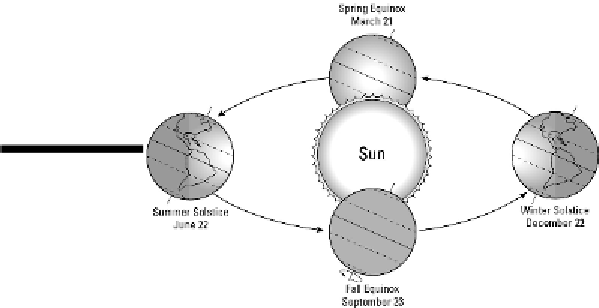Geography Reference
In-Depth Information
In Chapter 8, I discuss how solar energy causes water to evaporate and plants to
transpire
(sweat),
producing atmospheric vapor, the building blocks of raindrops and of other forms of precipitation.
Generally, the greater the solar energy, the greater the amount of evaporation and transpiration, which
result in vapor in the atmosphere. And the greater the amount of atmospheric vapor, the greater the
likelihood of precipitation. Given that Manaus experiences much more intense concentrations of sol-
ar energy than does Churchill, its atmosphere is much more humid and therefore has a higher rainfall
potential. Indeed, the very heat that produces that vapor may also create an atmospheric upwelling, or
convection current,
which carries vapor to a high altitude where it cools, condenses, and falls as rain
(see Figure 9-9 later in the chapter).
Tilt-a-World: The Reasons for the Seasons
Earth's axis is not, in reality, “straight up and down” as indicated by Figure 9-1. Instead, it's
tilted by 23 1/2° from the perpendicular. As a result, the vertical rays do not “stay put” at the
equator as Earth orbits the sun. Instead, they “migrate” north and south of the equator at differ-
enttimes ofyear,bringingwiththem patterns ofseasonal change (asillustrated byFigure9-2).
Take, for instance, the United States. During summer, the vertical rays move into the North-
ern Hemisphere, increasing its “dosage” of solar energy and producing the warm temperatures
that are associated with that time of year. During winter, however, the vertical rays move into
the Southern Hemisphere, greatly increasing that region's solar dosage but at the same time
greatly decreasing the dosage that hits the United States.
Figure 9-2:
Earth's inclina-
tion at different
points in its orbit
of the sun.



